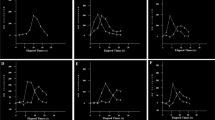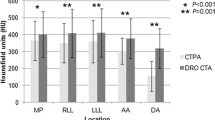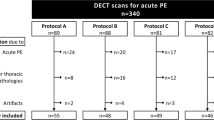Abstract
Purpose
The aim of this study was to assess the effectiveness of the modified test-bolus (mTB) method in computed tomography pulmonary angiography (CTPA).
Materials and methods
The Institutional Review Board approved this retrospective study. We reviewed 24 patients (nine men, 15 women; age range, 21–88 years) in whom CTPA was performed either by Bolus-Tracking (BT) (n = 12) or mTB (n = 12) methods. Pulmonary transit time (PTT) was used to determine scan delay time and contrast volume in the mTB group. The contrast volume, radiation dose, quantitative measures, and qualitative scores of enhancement were compared. The chi-squared test, Mann–Whitney U test, and κ statistics were used. The significance level was 0.05.
Results
The effective dose (P = 0.028) and contrast volume (P < 0.001) was significantly lower in the mTB group than those in the BT group. The difference in the quantitative measures and qualitative scores of enhancement between groups was statistically insignificant (P = 0.729, P = 0.635, respectively). Significantly fewer artefacts were observed in the mTB group (P = 0.024).
Conclusion
By taking into account PTT, mTB appears to be a promising method for tailoring CTPA to the patient with the use of less contrast material and resulting in fewer artifacts.



Similar content being viewed by others
Abbreviations
- BT:
-
Bolus-tracking
- CT:
-
Computed tomography
- CTDI:
-
Computed tomography dose index
- CTPA:
-
Computed tomography pulmonary angiography
- DLP:
-
Dose-length product
- ED:
-
Effective dose
- mTB:
-
Modified test-bolus
- PTT:
-
Pulmonary transit time
- ROI:
-
Region of interest
- t cont :
-
Contrast delivery time
- TCPaorta :
-
Time of contrast peak in the aorta
- TCPpulm :
-
Time of contrast peak in the pulmonary trunk
- t delay :
-
Scan delay time
- TB:
-
Test-bolus
- t scan :
-
Scanning time
References
Remy-Jardin M, Remy J, Wattinne L, Giraud F. Central pulmonary thromboembolism: diagnosis with spiral volumetric CT with the single-breath-hold technique—comparison with pulmonary angiography. Radiology. 1992;185:381–7.
Nyman U, Almén T, Aspelin P, Hellström M, Kristiansson M, Sterner G. Contrast-medium-induced nephropathy correlated to the ratio between dose in gram iodine and estimated GFR in ml/min. Acta Radiol. 2005;46:830–42.
Henzler T, Meyer M, Reichert M, Krissak R, Nance JW Jr, Haneder S, et al. Dual-energy CT angiography of the lungs: comparison of test bolus and bolus tracking techniques for the determination of scan delay. Eur J Radiol. 2012;81:132–8.
Kerl JM, Lehnert T, Schell B, Bodelle B, Beeres M, Jacobi V, et al. Intravenous contrast material administration at high-pitch dual-source CT pulmonary angiography: test bolus versus bolus-tracking technique. Eur J Radiol. 2012;81:2887–91.
Lee CH, Goo JM, Lee HJ, Kim KG, Im J-G, Bae KT, et al. Determination of optimal timing window for pulmonary artery MDCT angiography. AJR. 2007;188:313–7.
Rodrigues JCL, Mathias H, Negus IS, Manghat NE, Hamilton MCK. Intravenous contrast medium administration at 128 multidetector row CT pulmonary angiography: bolus tracking versus test bolus and the implications for diagnostic quality and effective dose. Clin Radiol. 2012;67:1053–60.
U-King-Im JM, Freeman SJ, Boylan T, Cheow HK. Quality of CT pulmonary angiography for suspected pulmonary embolus in pregnancy. Eur Radiol. 2008;18:2709–15.
Bae KT. Intravenous contrast medium administration and scan timing at CT: considerations and approaches. Radiology. 2010;256:32–61.
Bulla S, Pache G, Bley T, Langer M, Blanke P. Simultaneous bilateral contrast injection in computed tomography pulmonary angiography. Acta Radiol. 2012;53:69–75.
Holmquist F, Hansson K, Pasquariello F, Björk J, Nyman U. Minimizing contrast medium doses to diagnose pulmonary embolism with 80-kVp multidetector computed tomography in azotemic patients. Acta Radiol. 2009;50:181–93.
Johnson TRC, Nikolaou K, Wintersperger BJ, Fink C, Rist C, Leber AW, et al. Optimization of contrast material administration for electrocardiogram-gated computed tomographic angiography of the chest. J Comput Assist Tomogr. 2007;31:265–71.
Singh S, Kalra MK, Gilman MD, Hsieh J, Pien HH, Digumarthy SR, et al. Adaptive statistical iterative reconstruction technique for radiation dose reduction in chest CT: a pilot study. Radiology. 2011;259:565–73.
Henk CB, Grampp S, Linnau KF, Thurnher MM, Czerny C, Herold CJ, et al. Suspected pulmonary embolism: enhancement of pulmonary arteries at deep-inspiration CT angiography-influence of patent foramen ovale and atrial-septal defect. Radiology. 2003;226:749–55.
Bach AG, Schramm D, Behrmann C, Spielmann RP, Surov A. Estimation of pulmonary transit time as a by-product in standard CT pulmonary angiography. Acta Radiol. 2013;54:22–3.
Shors SM, Cotts WG, Pavlovic-Surjancev B, François CJ, Gheorghiade M, Finn JP. Heart failure: evaluation of cardiopulmonary transit times with time-resolved MR angiography. Radiology. 2003;229:743–8.
Lakoma A, Tuite D, Sheehan J, Weale P, Carr JC. Measurement of pulmonary circulation parameters using time-resolved MR angiography in patients after Ross procedure. AJR. 2010;194:912–9.
Jeong HJ, Vakil P, Sheehan JJ, Shah SJ, Cuttica M, Carr JC, et al. Time-resolved magnetic resonance angiography: evaluation of intrapulmonary circulation parameters in pulmonary arterial hypertension. J Magn Reson Imaging. 2011;33:225–31.
Bauer RW, Schell B, Beeres M, Wichmann JL, Bodelle B, Vogl TJ, et al. High-pitch dual-source computed tomography pulmonary angiography in freely breathing patients. J Thorac Imaging. 2012;27:376–81.
Heyer CM, Mohr PS, Lemburg SP, Peters SA, Nicolas V. Image quality and radiation exposure at pulmonary CT angiography with 100- or 120-kVp protocol: prospective randomized study. Radiology. 2007;245:577–83.
Report of AAPM Task Group 23. The Measurement, Reporting, and Management of Radiation Dose in CT. AAPM Report No. 96. Available from: http://www.aapm.org/pubs/reports/rpt_96.pdf.
Wittram C, How I. Do it: CT pulmonary angiography. AJR. 2007;188:1255–61.
Coche E, Verschuren F, Keyeux A, Goffette P, Goncette L, Hainaut P, et al. Diagnosis of acute pulmonary embolism in outpatients: comparison of thin-collimation multi-detector row spiral CT and planar ventilation-perfusion scintigraphy. Radiology. 2003;229:757–65.
Hartmann IJC, Wittenberg R, Schaefer-Prokop C. Imaging of acute pulmonary embolism using multi-detector CT angiography: an update on imaging technique and interpretation. Eur J Radiol. 2010;74:40–9.
Jeong YJ, Lee KS, Yoon YC, Kim TS, Chung MJ, Kim S. Evaluation of small pulmonary arteries by 16-slice multidetector computed tomography: optimum slab thickness in condensing transaxial images converted into maximum intensity projection images. J Comput Assist Tomogr. 2004;28:195–203.
Tack D, De Maertelaer V, Petit W, Scillia P, Muller P, Suess C, et al. Multi-detector row CT pulmonary angiography: comparison of standard-dose and simulated low-dose techniques. Radiology. 2005;236:318–25.
Heuschmid M, Mann C, Luz O, Mahnken AH, Reimann A, Claussen CD, et al. Detection of pulmonary embolism using 16-slice multidetector-row computed tomography: evaluation of different image reconstruction parameters. J Comput Assist Tomogr. 2006;30:77–82.
Nishino M, Kubo T, Kataoka ML, Gautam S, Raptopoulos V, Hatabu H. Evaluation of pulmonary embolisms using coronal reformations on 64-row multidetector-row computed tomography: comparison with axial images. J Comput Assist Tomogr. 2006;30:233–7.
Hunsaker AR, Oliva IB, Cai T, Trotman-Dickenson B, Gill RR, Hatabu H, et al. Contrast opacification using a reduced volume of iodinated contrast material and low peak kilovoltage in pulmonary CT angiography: Objective and subjective evaluation. AJR. 2010;195:W118–24.
Bédard JP, Blais C, Patenaude YG, Monga E. Pulmonary embolism: prospective comparison of iso-osmolar and low-osmolarity nonionic contrast agents for contrast enhancement at CT angiography. Radiology. 2005;234:929–33.
Adams DM, Stevens SM, Woller SC, Evans RS, Lloyd JF, Snow GL, et al. Adherence to PIOPED II investigators’ recommendations for computed tomography pulmonary angiography. Am J Med. 2013;126:36–42.
Yuan R, Shuman WP, Earls JP, Hague CJ, Mumtaz HA, Scott-Moncrieff A, et al. Reduced iodine load at CT pulmonary angiography with dual-energy monochromatic imaging: comparison with standard CT pulmonary angiography: a prospective randomized trial. Radiology. 2012;262:290–7.
Acknowledgments
This research received no specific grant from any funding agency in the public, commercial, or not-for-profit sectors. The local institutional review board (Gazi University Institutional Review Board: 2012, Ref. No: 360) approved this retrospective study.
Conflict of interest
We declare that we have no actual or potential conflicts of interest in relation to this article.
Author information
Authors and Affiliations
Corresponding author
About this article
Cite this article
Kilic, K., Erbas, G., Ucar, M. et al. Determination of lowest possible contrast volume in computed tomography pulmonary angiography by using pulmonary transit time. Jpn J Radiol 32, 90–97 (2014). https://doi.org/10.1007/s11604-013-0274-9
Received:
Accepted:
Published:
Issue Date:
DOI: https://doi.org/10.1007/s11604-013-0274-9




